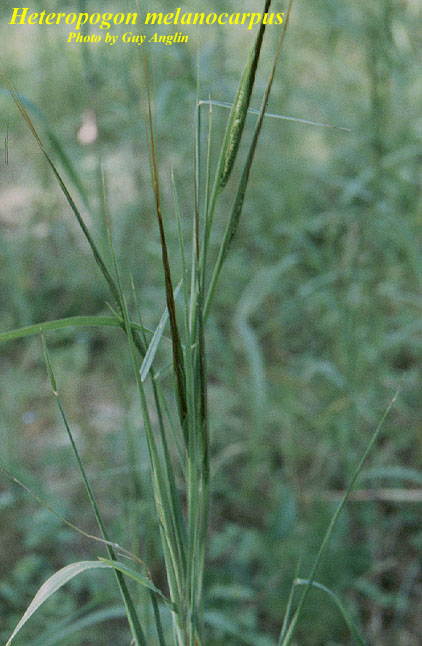Difference between revisions of "Heteropogon melanocarpus"
| Line 30: | Line 30: | ||
==Ecology== | ==Ecology== | ||
===Habitat=== <!--Natural communities, human disturbed habitats, topography, hydrology, soils, light, fire regime requirements for removal of competition, etc.--> | ===Habitat=== <!--Natural communities, human disturbed habitats, topography, hydrology, soils, light, fire regime requirements for removal of competition, etc.--> | ||
| − | The soils where ''H. melanocarpus'' was encountered during the study are fine sandy loams that are poorly drained with slow surface runoff and medium to very slow permeability.<ref name="Lewis and Harshbarger 1976"/> It has also been found in wet to dry loamy sand, and seems to prefer semi-shaded to open light conditions (FSU Herbarium). ''H. melanocarpus'' can be found in annually burned savannas, as well as in disturbed habitat such as beside trails, roadsides, railroad beds, old fields, and firebreaks (FSU Herbarium). Associated species include Senna obtusifolia, Conzya pusilla, Strophostyle helvola, Bidens alba,'' and ''Andropogon glomeratus'' (FSU Herbarium). | + | The soils where ''H. melanocarpus'' was encountered during the study are fine sandy loams that are poorly drained with slow surface runoff and medium to very slow permeability.<ref name="Lewis and Harshbarger 1976"/> It has also been found in wet to dry loamy sand, and seems to prefer semi-shaded to open light conditions (FSU Herbarium). ''H. melanocarpus'' can be found in annually burned savannas, as well as in disturbed habitat such as beside trails, roadsides, railroad beds, old fields, and firebreaks (FSU Herbarium). Associated species include ''Senna obtusifolia, Conzya pusilla, Strophostyle helvola, Bidens alba,'' and ''Andropogon glomeratus'' (FSU Herbarium). |
===Phenology=== <!--Timing off flowering, fruiting, seed dispersal, and environmental triggers. Cite PanFlora website if appropriate: http://www.gilnelson.com/PanFlora/ --> | ===Phenology=== <!--Timing off flowering, fruiting, seed dispersal, and environmental triggers. Cite PanFlora website if appropriate: http://www.gilnelson.com/PanFlora/ --> | ||
Revision as of 19:17, 14 December 2015
| Heteropogon melanocarpus | |
|---|---|

| |
| Photo by Guy Anglin, Atlas of Florida Vascular Plants | |
| Scientific classification | |
| Kingdom: | Plantae |
| Division: | Magnoliophyta - Flowering plants |
| Class: | Liliopsida – Monocotyledons |
| Order: | Cyperales |
| Family: | Poaceae ⁄ Gramineae |
| Genus: | Heteropogon |
| Species: | H. melanocarpus |
| Binomial name | |
| Heteropogon melanocarpus (Elliott) Elliott ex Benth. | |

| |
| Natural range of Heteropogon melanocarpus from USDA NRCS Plants Database. | |
Common name: sweet tanglehead
Synonym: Andropogon melanocarpus Elliott
Contents
Taxonomic notes
Description
Heteropogon melanocarpus is an annual graminoid.
Distribution
Ecology
Habitat
The soils where H. melanocarpus was encountered during the study are fine sandy loams that are poorly drained with slow surface runoff and medium to very slow permeability.[1] It has also been found in wet to dry loamy sand, and seems to prefer semi-shaded to open light conditions (FSU Herbarium). H. melanocarpus can be found in annually burned savannas, as well as in disturbed habitat such as beside trails, roadsides, railroad beds, old fields, and firebreaks (FSU Herbarium). Associated species include Senna obtusifolia, Conzya pusilla, Strophostyle helvola, Bidens alba, and Andropogon glomeratus (FSU Herbarium).
Phenology
Flowering and fruiting has been observed in July through November (FSU Herbarium).
Seed dispersal
Seed bank and germination
Fire ecology
This species has been found in annually burned savanna (FSU Herbarium).
It was found only in plots receiving periodic winter burning in Lewis and Harshbarger's experiment.[1]
Pollination
Use by animals
Diseases and parasites
Conservation and Management
Cultivation and restoration
Photo Gallery
References and notes
Florida State University Robert K. Godfrey Herbarium database. URL: http://herbarium.bio.fsu.edu. Last accessed: June 2014. Collectors: Loran C. Anderson, R. Komarek, James R. Burkhalter, R. K. Godfrey, James D. Ray Jr., A. H. Curtiss, Robert L. Lazor, Norlan C. Henderson, A. F. Clewell, R. A. Norris, R. F. Doren, Angela M. Reid, and K. M. Robertson. States and Counties: Florida: Bay, Columbia, Duval, Escambia, Hernando, Jefferson, Leon, Santa Rosa, Taylor, and Wakulla. Georgia: Grady.